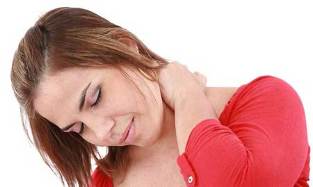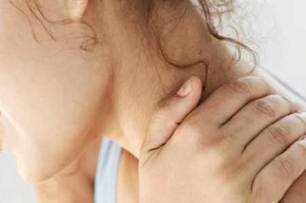In the world there are little illnesses, which include people, just because he – man. For example, vascular disease and the deposition of cholesterol on the walls for quick access to wildlife is also found in the. The symptoms of osteochondrosis of the neck may be confused with symptoms of other diseases. Increased blood pressure is the same in all warm-blooded animals. Incorrect nutrition can lead to exhaustion and chard in protein and vitamins, and chicken, and an elephant, and in the case of the mollusk, and fighters of the free style. But osteochondrosis of the spine refers to diseases that can be proud of a man, even his closest relatives – the primates, the disease is almost non-existent. You examine the manifestations, symptoms and treatment options of degenerative disc of the neck, diseases of the spine.

Cervical osteochondrosis, what is it?
Osteochondrosis of the cervical spine is a disease of the bone and cartilage tissue, are the dystrophic — degenerative. Underlying dystrophy (eating disorders, cartilage), and then its destruction or Degeneration. In fact, in the case of osteochondrosis suffer from primary cartilage, intervertebral discs, and then "snowball" is supplemented by the reaction of the bone tissue (osteophytes be associated), the formation of protrusion and hernia, the root of your symptoms, the emergence of instability in the cervical spine, as well as acute headaches and chronic muscle spasm of the deep muscles of the neck, with disruption of the regional circuit. The cause of osteochondrosis of the intervertebral discs in the cervical spine or in the schejno – chest Department of a: it is the historically established vertical Position of the people. Neither cats, nor in cows or hippos there are no such constant axial load on the vertical spine, the spine is in a relaxed, "floppy" condition, and the discs feel comfortable. In humans to the development of cervical degenerative disc the following factors predispose:
- Frequent finding in the upright Position;
- Injuries and sudden movements, bumps with the head, for example, low ceilings;
- The carrying of loads on the shoulders, in some countries – on the head;
- The noticeable lack of active movement. It leads to a weakness of the muscle corset of the spine is of crucial importance in the neck.
Among other factors, the wearing of heavy Winter collar and fur hats, with the aim of "fashion" to serve, to low fluid intake, resulting in the primary drainage of the cartilage fabric. This increases the fragility of the disk and calls out, "you Drawdown" (narrowing of the thickness), whereby the elastic buffer properties. To lead In the youth osteochondrosis-a violation of posture in the execution of the written tasks and the work on the Computer. Congenital changes in the spine, for example scoliosis deformation in the area of the thoracic spine. Keep in mind — the higher the spine is, the stronger the pulse, the can is also a damaging effect, similar to the "whiplash" injury. Therefore, breakage or impaired compensatory mechanisms, preservatives nerve in our skull, by the excessive vibration leads to the spine osteochondrosis of the neck. Here are these reasons:

- Flat feet, both longitudinal and transverse. The arch of the foot, excluding depreciation, incapable of the intervertebral discs of the cervical spine of the vibration and to protect destruction;
- The lower-lying osteochondrosis of the lumbar spine. When the elasticity is broken in the lower back area, do not expect a good protection of the cervical spine.
Symptoms of degenerative disc disease of the cervical spine
Signs of degenerative disc disease of the cervical spine are very diverse, but all of them can be grouped on the local and remote symptoms. Among the local symptoms of cervical degenerative disc disease:
- Nagging and aching muscle pain, low intensity, worse after prolonged sitting, for example, when working in the office and on the Computer;
- Crunching in the neck move. It is the strongest to feel, in the execution of the exercises in the morning, in case if the fingers stuck in the ears. Then the bone conductivity of sound exceeds the air, and when turning the neck crunching can be heard. This Symptom is a Testament to the emergence of osteophytes in violation of the congruence (the accuracy of the matter) cartilage and vertebrae;
- Neck pain, such as in the case of the movement (usually sharp). This pain can be referred to as the Servicio, similar to the "shot" in the lower back, the lumbago. Such a pain already belong to radicular manifestations of osteochondrosis. They arise when a strong shake of the nerves, the pressing happens when laughing, coughing, sneezing,. This pain reminds neuralgia, and is comparable with the effect of the electric current in its force and suddenness. Most commonly, it arises of the spine in the chest;
To include the remote features:
- Headaches at a cervical osteochondrosis. Arise imperceptibly, reminiscent of the "helmet" or "helmet", often symmetrically. Their low intensity, you can in connection with the movement, but not necessarily. Often you have to go "" on the head with the nape of the neck, and accompany and lack of exercise.
- Implementation of sensitivity disorder. Often arise at night – awakening, you get the feeling that he's deaf Institute Finger. Most often it is the little Finger and half the ring finger on the side of the little finger. Sensitivity, recovering, you need your arms, neck and change the attitude.
This is done by affecting the nerves, cervical Plexus, roots of varieties of nerves. It is important that the roots be injured for the most part, spasserovannye muscles of the neck, the prilezhat to the vertebrae. Cervical osteochondrosis, the symptoms we have can be complicated spinal instability in the neck. The height of all intervertebral discs in the cervical spine is uniformly reduced, and the neck you get a "pathological mobility," or the tendency for the emergence of pain and different deformations when driving. In this condition, the frequent occurrence of the injury arises nerve roots and increases the risk of protrusion and hernia.

The role of the muscle spasm
There is a secondary muscle spasms, which as myofascial — Tonic syndrome. This condition can be in various areas of the spine, anywhere where there is cross — striped muscles. As a result of the decrease in the height of the intervertebral disc, and the expansion of the regional osteophytes, the muscles are "tightened" and their blood supply is deteriorating. Reduced accordingly and the venous return flow. Such a Situation leads to swelling of the muscles and chronic spasms, the pain and stiffness in the neck and back.
Diagnosis of osteochondrosis of the cervical spine
In typical cases, the osteochondrosis of the cervical spine with the symptoms described. Therefore, the most important step in diagnostics is the determination of the complaints of the patients, the finding that the accompanying muscle spasms due to the simple Palpation of the muscles along the spine. To confirm the diagnosis of degenerative disc disease with the help of the x-ray examination:
- "X-ray" of the cervical spine, with the functional Tests for flexion – extension does not show cartilage, since your fabric skips the x-rays.
In spite of this, according to the arrangement of the vertebrae can draw General conclusions about the height of the intervertebral disc, General, equal to the direction of the physiological curvature of the cervical lordosis, as well as the presence of the regional growths will be brittle to the vertebrae in the irritation of their surfaces and dehydrated intervertebral discs discs. Functional Tests allow the diagnosis to the spine to confirm instability of the neck;
- Magnetic resonance and x-ray computed tomography shows the clarification of the inner structure of cartilage and the formation of protrusion and hernia.
So accurate diagnosis of complications of the disease and the result of the tomography is an indication for surgical treatment of hernias in the Department of neurosurgery is.
Treatment of cervical degenerative disc disease, drugs
The treatment of osteochondrosis of the cervical spine was always complex: first, acute pain can be removed with the help of drugs, then, when cervical osteochondrosis (pain reducing), it will be through the physiotherapy and Massage techniques, and to alleviate this aggravation, the Phase of the secondary prevention, their task is the prevention of repeated exacerbations begins. Sometimes, a Patient is assigned to treatment. The most important groups of drugs for the relief of acute pain are:
- Non-steroidal anti-inflammatory drugs. Cropped inflammatory component;
- Central Muscle Relaxants Action . Lower the tone of the spasm of the muscles, reduce pain, stiffness in the muscles;
- B vitamins – contribute to the improvement of the trophism of the nerve tissue;
- Drugs to improve microcirculation capillary blood — outflow improve and normalize the function of the muscles.
These funds will be allocated to, or within, or intramuscularly for more efficiency. Target is the elimination of acute pain syndrome. Then, after 2-3 days, you will travel with the taking of tablets, active ointments or gels, the HSR in the neck and the back. In a second step, the physiotherapy techniques electrophoresis to connect with vitamins and hydro-cortisone, Massage, underwater traction, and a waterfall shower, a iglorefleksoterapevta techniques. Sometimes prescribe medications – chondroprotectors, but if you have not proven you inside their effectiveness so far. Only intra-articular replacement for synovial fluid reduced grinding, to facilitate movement and eliminate pain. But in the case of osteochondrosis this technique, proven in the large joints, is almost not applied. Surgical treatment in severe compression of the back of the protrusion or disc herniation sensitive or motor book. The indication for surgery is refractory severe pain in the course of the month, intractable to treatment, or the progression of weakness in the muscles of the hands, which is an extension of the Zone of diminishing sensitivity, as well as the confirmation of the diagnosis, and protrusion of hernia by MRI or CT.
Exercises with cervical osteochondrosis
Gymnastics in osteochondrosis of the neck nothing more than a rational observance of motor activity and maintain a healthy lifestyle is the spinal column: because, osteochondrosis occurs in all men without exception, starting with the age of the child, and also somewhere as a "variant of Norm". Since there is no such Person, the diseases, especially in adult age would have signs of degenerative disc, is the object of the gymnastics is the only objective, radio-logical signs of the disease, and you eliminate all the complaints. It is known that older and old people can prevention is not a complaint to your neck and back, but only if there is enough time devoted.
Prevention of cervical degenerative disc disease
Perhaps the example of the osteochondrosis of the principles of prevention, which show everything and everyone, and as a result, we obtain the rules of a healthy life style bring. Here they are:

- Free movement, without unnecessary burdens, exercises without load, only with the mass of his body;
- The drinking of large quantities of pure water, because with increasing age, dehydration of the cartilage tissue;
- Save or normalization of body weight;
- Employment with such types of loads, drops in which the load on the back (swim);
- The avoidance of harmful habits;
- Change of of mental with physical stress. In each hour – one and a half mental work it is recommended that the type of activity on the physical work;
- The avoidance of supercooling, the neck, the back, especially in the spring – autumn.
Only at observance of these simple recommendations osteochondrosis of the cervical spine, symptoms, and treatment, which we dissected in Detail, not coming years are disturbing.

































